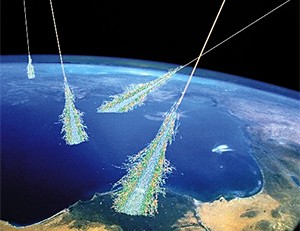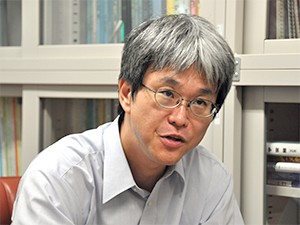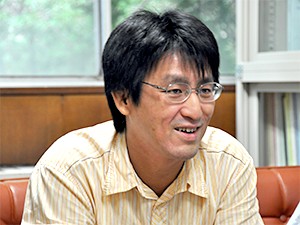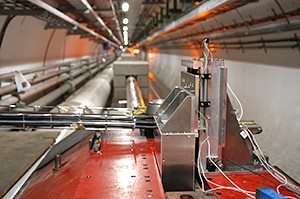Features
Features
Cosmic rays still at large
- ツイート
- 2010/09/30
The Large Hadron Collider, the world's largest and most advanced particle accelerator, provides an unprecedented chance for scientists to understand the origin of ultrahigh-energy cosmic rays
 Out there, somewhere in the Universe, an unknown source is accelerating charged particles to very high energies. When these high-energy particles, known as cosmic rays, strike Earth's upper atmosphere, they collide violently with molecules in the air, mainly nitrogen and oxygen, to produce an 'air shower' -- a cascade of elementary particles.
Out there, somewhere in the Universe, an unknown source is accelerating charged particles to very high energies. When these high-energy particles, known as cosmic rays, strike Earth's upper atmosphere, they collide violently with molecules in the air, mainly nitrogen and oxygen, to produce an 'air shower' -- a cascade of elementary particles.
Cosmic rays are interesting not only for their usefulness in studying elementary particles, but also for their very existence as one the highest-energy phenomena in the Universe. Of all the mysteries that surround cosmic rays, the origin of ultrahigh-energy cosmic rays has remained one of the biggest enigmas in modern physics. In 1966, Kenneth Greisen, Georgiy Zatsepin and Vadim Kuzmin predicted that there would be very few cosmic rays with energies greater than 5×1019 electronvolts (eV) due to energy lost through interactions with the cosmic microwave background photons that fill the Universe. However, in the 1990s, scientists working with the Akeno Giant Air Shower Array (AGASA) in Japan reported the observation of cosmic rays with energies exceeding 1020 eV. This contradictory result, known as the Greisen-Zatsepin-Kuzmin (GZK) paradox, is one of the hottest topics in physics. If the energy cut-off does not exist, it could imply the existence of as-yet unknown physics.
"The problem is that we do not have enough knowledge about collisions between ultrahigh-energy cosmic rays and air molecules to resolve the GZK paradox," says Professor Yoshitaka Itow, a member of the Quest for Fundamental Principles in the Universe GCOE program. He and Associate Professor Takashi Sako have been studying cosmic rays at Nagoya University's Solar-Terrestrial Environment Laboratory for many years. They are also members of the Large Hadron Collider 'forward' (LHCf) project, an experiment designed to study particles generated in the forward region of high-energy collisions.

The Large Hadron Collider (LHC) in Geneva, Switzerland, is the largest particle accelerator in the world and can accelerate particles up to 1012 eV. It offers scientists the opportunity for the first time to simulate collisions between ultrahigh-energy cosmic rays and air molecules and to obtain concrete knowledge on how the air shower develops.
Squeezing the uncertainty
Following AGASA, several other experimental groups also confirmed the existence of ultrahigh-energy cosmic rays. AGASA even went so far as to claim that there was no evidence of an energy cut-off, but their data points were too few to be conclusive. In 2004, scientists at the Pierre Auger Observatory in Malargue, Argentina, reported observations indicating a distinct energy cut-off somewhere between 1019 and 1020 eV. The detector at the Pierre Auger Observatory is quite large, almost 3,000 square kilometers in area, so the statistical error in this finding is expected to be small.
"There are many contradictory results and uncertainties. We believe that the uncertainties are due mainly to our lack of knowledge about high-energy collisions. We would like to 'squeeze' the uncertainty by using results from the LHC, which should clear up the confusions in our interpretation," says Itow. One of the points of debate among scientists has been whether cosmic rays are protons or something else. "The situation right now is quite confusing. Just this year, scientists from the Pierre Auger Observatory published data that suggest cosmic rays might actually be iron nuclei. The chemical composition of cosmic rays is another mystery, and we hope the LHC will help find the answer."
All things being equal
At present, there are six experimental projects in progress at the LHC. Four of these are large-scale international collaborations, each involving thousands of scientists, and a fifth project is a mid-size experiment involving more than a hundred scientists. LHCf is the smallest project, with only 36 members -- of which 19 are Japanese and 11 are from Nagoya University. Other members are from Italy, France, Switzerland, Spain and the USA.

"Our task in the LHCf experiment is not just to acquire data; every day we hold meetings with representatives from the other LHC experiments as well as LHC operators and coordinators," says Sako. Meetings are held every morning, even on weekends, to discuss how to operate the accelerator over the next two weeks. "We usually do not have too many requests, but if we do, sometimes we find a conflict with other big experiments. The coordinators always listen to our request in a very democratic way. Even though we have only 36 members, they try to treat us equally. This experience is very rare in international collaboration, especially for Japanese researchers."
On the collision front
Most experiments at the LHC aim to find new particles produced by proton-proton collisions, so in principle, detectors are only needed radially around the collision point. For the LHCf experiment, however, particles that shoot forward in line with the incoming particles are more important. To detect these 'forward' particles, Itow, Sako and their co-workers have installed a detector directly in front of the accelerator, 140 meters from the collision point. Such measurements, at exactly 0°, are rare in particle physics but are needed in order to track how air shower develops.
The LHC runs 24 hours a day, but much of that time is devoted to trials that must be completed before conducting actual collision experiments. The LHCf detector has to be taken out of the beam line during these trials and reinserted when a collision is scheduled. This means that at least two members of the small LHCf team must be on standby at all times, working in eight-hour shifts through the day and night.
 For such a small team with only a dozen or so core members, the shift work is tough, but in mid-July the researchers finished their first round of experiments and are now concentrating on data analysis. Despite having a large amount of data to get through, some very interesting results have already emerged. For example, by comparing various simulation models with LHCf data at relatively low energies of around 1011 eV, the researchers have identified a model that best describes the air shower. The next step will be analyzing data at higher energies and seeing if the model continues to hold.
For such a small team with only a dozen or so core members, the shift work is tough, but in mid-July the researchers finished their first round of experiments and are now concentrating on data analysis. Despite having a large amount of data to get through, some very interesting results have already emerged. For example, by comparing various simulation models with LHCf data at relatively low energies of around 1011 eV, the researchers have identified a model that best describes the air shower. The next step will be analyzing data at higher energies and seeing if the model continues to hold.
The LHC is not yet operating at its designed peak energy of 7×1012 eV. According to the LHC's development schedule, that level of operation is expected to be reached in 2013. Such high energy will be particularly important to LHCf research because it will allow researchers to extrapolate the model with unprecedented precision.
For now, the LHC is only producing proton-proton collisions, but by the end of this year, the LHC will be ready to produce lead-lead collisions. "Although there might be some debate about whether cosmic rays are protons -- as we believe -- or carbon or iron nuclei, we are certain that in the atmosphere at least, the collisions are not proton-proton collisions. Observing collisions between heavier nuclei will help us perfect our science," says Sako.
NU Research
(English)

